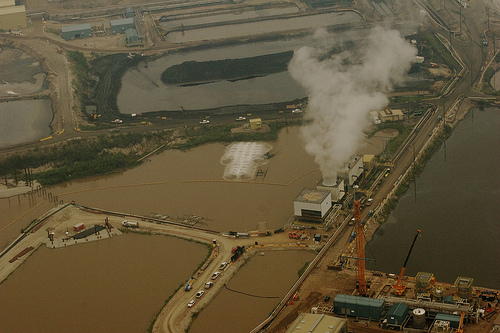FairweatherHill.com November 3rd, 2014
Traditional energy projects in Atlantic Canada have been as much about the politics of short-term jobs and saving political bacon as they’ve been about long-term economic vision.
Joey Smallwood needed jobs from the Churchill Falls project to help his re-election in 1966 and he was willing to sign a “controversial” power deal with Quebec to get them.
While Joey was sparring with Quebec, Nova Scotia was doing a deal with Ottawa that would see a Heavy Water plant built in Glace Bay to manufacture cooling water for Canada’s Nuclear industry. That project did provide needed employment to industrial Cape Breton. But, it produced very little heavy Water. The last remains of the heavy water plant were recently cleared away at federal expense.
Of course, there have been notable exceptions to this history, offshore oil and gas has transformed the economy of Newfoundland and Labrador and to a lesser extent, Nova Scotia, and still holds potential for future growth.
New Brunswick Premier David Alward, in 2013, promised jobs from the building of a heavy oil pipeline and from the potential development of shale gas. New Brunswickers just needed to believe there were huge game-changing benefits, and no risks, in these developments. The promoters of large capital-intensive developments like hydro, heavy water, or as in the case of New Brunswick, nuclear and pipelines, have always understood these realities and have used them to advantage, especially near election time.
As we know, with a hydro deal in hand, Smallwood went on to win re-election in ’66. Today’s public may be a tad more cynical than their parents were in the ’60s. Premier Alward’s pitch to voters fell short and his PC’s became New Brunswick’s second, consecutive, one term government when they were turfed out in 2014.
New Brunswick voters, as it turns out did have a memory. They remembered successive failures to launch promised big energy projects; a second nuclear reactor, a second oil refinery, and an LNG import terminal that was not needed by the time it was commissioned.
It would be a mistake, though, to think that voters are simply souring on “Big Energy”, when the real issue is cynicism over the notion that big projects are the silver bullet to reversing our economic decline and that all government has to do is get out of the way.
Governments have fallen out of their traditional role. That is, to govern, ensuring that development is in the public interest and driven by the right balance of economics and environmental principle. The reality is that policitians have become cheerleaders, not stewards of the public interest. Politicians have as much responsibility for the resulting loss of social license as have the promoters. Public voices are beginning to ask, “if government isn’t see as actively managing that balance, who is?” New Brunswick voters might just be in the vanguard of a growing awareness of the importance of getting that right than some of our leaders.
While the incoming Gallant government can expect to see considerable jockeying by project promoters and their opponents, events unfolding outside the region will ultimately determine the fate of any new export focussed energy development here.
In the meantime, we must decide under what terms development should occur and we should have that debate now as the landscape is changing rapidly. The “managed” public consultations to which we’ve grown accustomed, aren’t the answer to regaining public trust or preparing us for the complexity of issues we have to confront.
Weakening oil markets, growing demands for necessary action on climate change, an expanding range of increasingly efficient renewable energy options and more distributed energy production are not short-term issues. They are deepening trends that, taken in totality, represent a change in the way we will produce, distribute and consume energy.
These trends will also impact the potential of New Brunswick’s shale gas industry. Politicians and public policy practitioners need to cut through the conflicting signals; The global market for renewable energy development to 2035 may be $23 trillion, but the estimated required expenditures on fossil fuels are greater, at more that $30 trillion; and While more than $300b in fossil fuel assets may be stranded if a low-carbon strategy is adopted worldwide after 2015, not all fossil fuels will be impacted uniformly. New Brunswick’s shale gas resources should be marketable long after coal production, for example, has ceased to be viable.
Industry understands that fossil fuel demand is subject to future policies aimed at reducing GHG emissions and is preparing in varying degrees to meet the challenge. But the stark reality, according to Christiana Figueres, Executive Secretary of the United Nations Framework Convention on Climate Change (UNFCCC), is that if we are to meet climate change targets, then fossil fuel consumption has to peak and then decline within this decade. Investment will soon flow mainly to high-graded opportunities while marginal development will increasingly have to be abandoned.
Clearly, investment predicated on continued growth in consumption will be unattractive if there is a risk that the assets financed will be stranded. In this environment, New Brunswick needs to be realistic about the potential for natural gas development and the impact of its “fracking” moratorium. We need to understand the implications of taking ourselves out of contention for one of the remaining fossil fuel investment opportunities even as we should have an eye out for opportunities in emerging energy technologies.
We’ll have to see if our new leaders can juggle more than one issue at a time or even if their horizon is wide enough to allow them to keep an eye on maturing opportunities as well as those that are just emerging. Investors will certainly have an ear to the ground. Lets hope our politicians have theirs there as well.
We’ll soon see if they’re listening…
(This is an excerpt from a more extensive opinion piece I wrote recently on energy trends and implications for Atlantic Canada. I’ll post it here when I’m able to release it)








